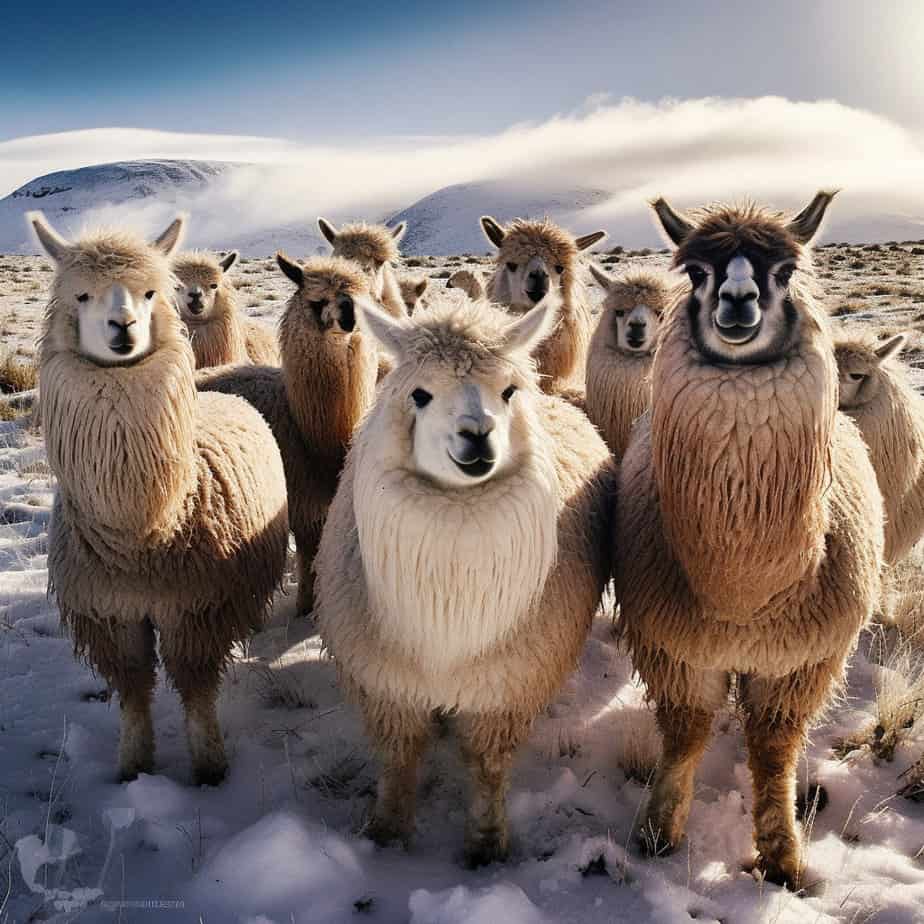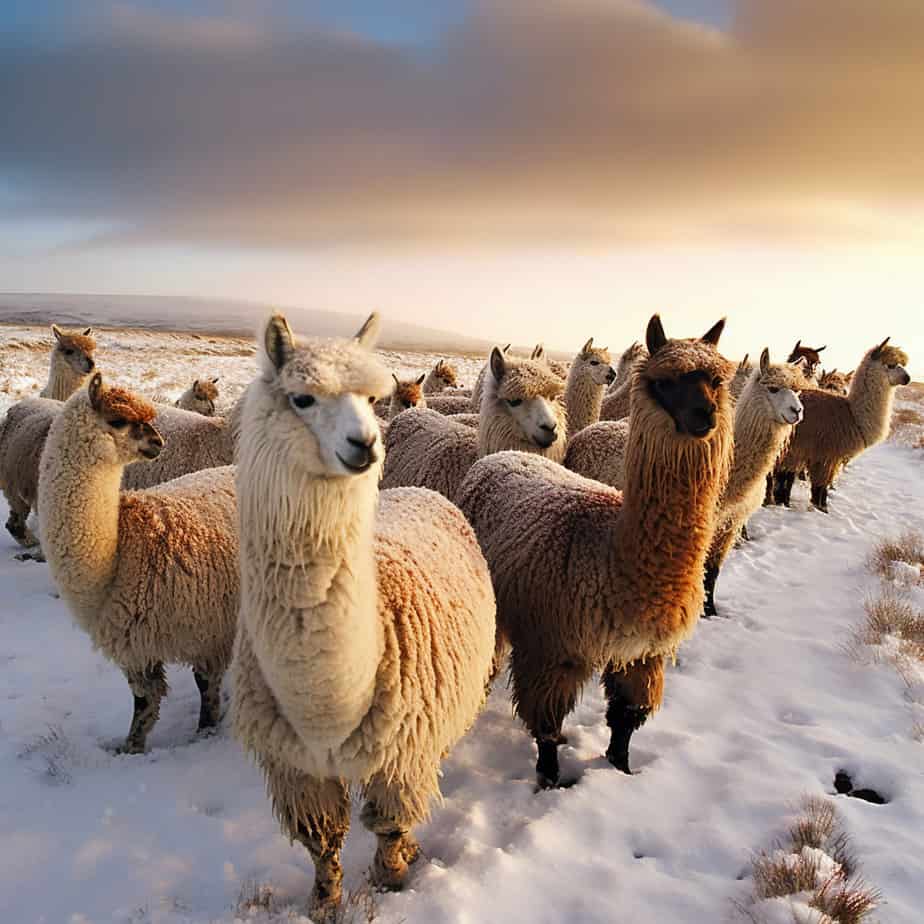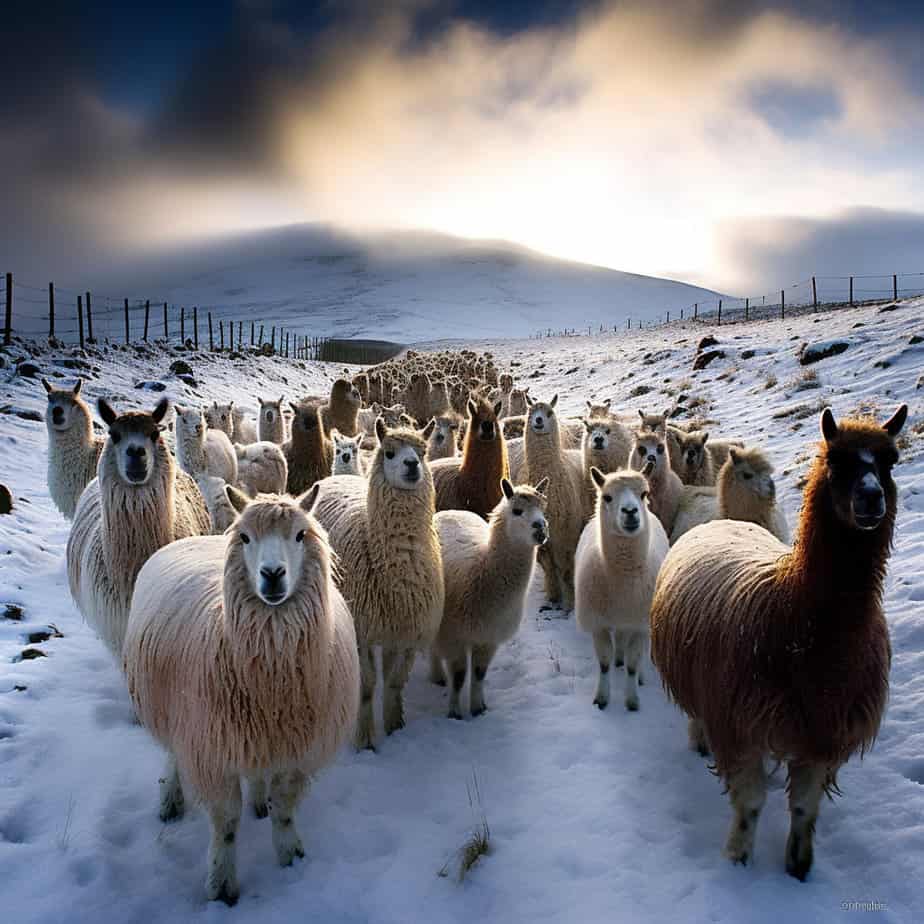Llamas are fascinating creatures that have adapted to various climates, but just like any other animal, they have their limits when it comes to cold weather. Understanding how cold is too cold for llamas is crucial for their well-being and overall health. Llamas are native to the high altitudes of the Andes Mountains in South America, where temperatures can drop significantly. However, domesticated llamas may not be as resilient to extreme cold as their wild counterparts. In this article, we will explore the ideal temperature range for llamas, the signs of cold stress to watch out for, and how to protect these gentle animals during chilly weather. So, let’s dive in and learn more about how to keep our furry friends warm and comfortable in colder climates.
Key Takeaways
- Llamas are adapted to cold climates and can tolerate temperatures as low as -20°F (-29°C).
- However, factors such as wind chill, humidity, and the llama’s age, health, and coat condition can affect their tolerance to cold.
- It is important to provide shelter, adequate bedding, and access to fresh water and food to ensure the well-being of llamas in cold weather.
- Monitoring their behavior and body condition can help determine if the cold is becoming too extreme for llamas.
Understanding Llama’s Adaptation to Cold

A. The Natural Habitat of Llamas
Llamas are native to the harsh and cold climates of the Andes Mountains in South America. These majestic creatures have evolved over thousands of years to survive in extreme weather conditions, including freezing temperatures, high altitudes, and strong winds. Understanding their natural habitat is crucial in comprehending their ability to adapt to cold.
In the wild, llamas roam freely in the rugged terrain of the Andes, where temperatures can drop well below freezing. They have developed certain behaviors and physical characteristics that enable them to thrive in these challenging environments. Llamas are hardy animals that have adapted to withstand the cold, making them an excellent choice for cold climate regions.
B. Llama’s Unique Physiological Adaptations
Llamas possess several unique physiological adaptations that help them cope with cold weather. These adaptations allow them to regulate their body temperature, conserve heat, and protect themselves from the elements. Let’s explore some of these remarkable adaptations:
-
Thick Woolly Coat: One of the most noticeable features of llamas is their thick, insulating coat. Their woolly fur provides excellent protection against the cold by trapping warm air close to their bodies. This natural insulation helps to keep them warm even in freezing temperatures.
-
Double-Layered Coat: Llamas have a double-layered coat consisting of a coarse outer layer and a soft, downy undercoat. This unique structure helps to repel moisture and insulate their bodies effectively. The outer layer acts as a barrier against rain, snow, and wind, while the undercoat provides additional warmth.
-
Thermoregulation: Llamas have the ability to regulate their body temperature efficiently. They can raise or lower their metabolic rate to adapt to changing environmental conditions. During cold weather, llamas conserve energy by reducing their metabolic rate, which helps them maintain their body heat.
-
Large Lungs and Efficient Respiration: Llamas have larger lungs and a more efficient respiratory system compared to other domesticated animals. This adaptation allows them to take in more oxygen at high altitudes, where the air is thinner and colder. Their efficient respiration helps them cope with the reduced oxygen levels and extreme cold of their natural habitat.
-
Thick Foot Pads: Llamas have thick foot pads that provide insulation and protection against the cold ground. These pads act as a barrier, preventing heat loss through their feet and reducing the risk of frostbite.
-
Behavioral Adaptations: Llamas exhibit certain behaviors to cope with cold weather. They often huddle together in groups, sharing body heat and providing mutual protection. This behavior helps them conserve energy and stay warm during freezing temperatures.
Understanding these unique physiological adaptations of llamas gives us insight into their remarkable ability to withstand cold climates. However, it’s important to note that even with their natural adaptations, llamas still require proper care and attention in extremely cold conditions. Providing them with adequate shelter, nutrition, and monitoring their health is essential for their well-being in cold weather.
The Science of Heat Transfer in Cold Conditions
A. The Concept of Heat Travelling to Cold
When it comes to understanding how cold weather affects llamas, it’s important to grasp the concept of heat transfer. Heat naturally moves from areas of higher temperature to areas of lower temperature, seeking equilibrium. This principle is known as heat transfer or heat flow.
In cold conditions, heat will always move away from the body of a llama, which is warmer, towards the colder environment. This process occurs through three main mechanisms: conduction, convection, and radiation.
-
Conduction: Conduction is the transfer of heat through direct contact between objects. When a llama comes into contact with a cold surface, such as icy ground or metal, heat is conducted away from the body, leading to a drop in body temperature.
-
Convection: Convection involves the transfer of heat through the movement of air or water. In cold weather, llamas can experience convective heat loss when cold air passes over their bodies, carrying away the heat. Windy conditions exacerbate this effect, as the moving air increases the rate of heat loss.
-
Radiation: Radiation occurs when heat is emitted in the form of infrared waves. Llamas lose heat through radiation to their surroundings, especially if those surroundings are colder than their body temperature.
B. How This Principle Applies to Llamas
Llamas have evolved to adapt to a wide range of climates, including cold environments. However, they do have limits to their cold tolerance. Understanding how heat transfer works helps us determine when the cold becomes too extreme for llamas.
Llamas have a thick coat of wool that provides insulation and helps retain body heat. This natural insulation reduces heat loss through conduction and radiation. Additionally, llamas have a unique circulatory system that allows them to regulate blood flow to their extremities, conserving heat in their core.
However, even with these adaptations, llamas can still be susceptible to cold weather conditions. Factors such as temperature, wind chill, humidity, and precipitation all play a role in determining how cold is too cold for llamas.
It’s important to monitor llamas closely during cold weather and be aware of signs of distress or discomfort. Some indicators that the cold may be affecting a llama include shivering, huddling, decreased activity, and a reluctance to move.
To ensure the well-being of llamas in cold conditions, it’s crucial to provide them with appropriate shelter, such as a well-insulated barn or shed. Additionally, providing access to fresh water and a balanced diet is essential for maintaining their overall health and body condition during winter.
In conclusion, llamas have a remarkable ability to adapt to cold weather, thanks to their natural insulation and circulatory system. However, extreme cold conditions can still pose a risk to their well-being. By understanding the science of heat transfer and closely monitoring their behavior and health, we can ensure that llamas stay comfortable and healthy even in chilly climates.
How Animals Keep Warm in Cold Conditions
A. The Role of Fur and Fat in Insulation
When it comes to surviving in cold conditions, animals have developed remarkable adaptations to keep themselves warm. One of the key mechanisms they employ is the insulation provided by their fur and fat. Let’s take a closer look at how these features help animals stay cozy even in freezing temperatures.
Fur: Nature’s Winter Coat
Fur is a natural insulator that helps animals retain body heat. It acts as a protective layer, trapping air close to the body and creating a barrier against the cold. The thickness and density of an animal’s fur play a crucial role in determining its ability to withstand low temperatures.
For example, animals living in colder climates, such as the Arctic fox or the polar bear, have thick, dense fur that provides excellent insulation. The multiple layers of fur trap air effectively, preventing heat loss and keeping the animal warm. In contrast, animals in milder climates, like deer or rabbits, have thinner fur, which still provides some insulation but is not as effective in extreme cold.
Fat: Nature’s Energy Reservoir
Fat, also known as adipose tissue, serves as an energy reservoir for animals during harsh winters. It acts as a source of insulation and provides a layer of protection against the cold. Animals accumulate fat reserves during the warmer months when food is abundant, and they utilize these reserves during periods of scarcity, such as winter.
Fat not only helps animals maintain their body temperature but also provides them with the necessary energy to survive when food sources are scarce. It acts as a fuel source, allowing animals to generate heat through metabolic processes. This stored energy helps them stay warm and active even when the external temperatures drop significantly.
B. Llama’s Mechanism of Staying Warm
Llamas, like other animals, have their own unique mechanisms for staying warm in cold conditions. These fascinating creatures have evolved to survive in the harsh climates of the Andes Mountains, where temperatures can plummet to freezing levels. Let’s explore how llamas adapt to the cold and ensure their well-being during winter.
Thick Woolly Coat
One of the most distinctive features of llamas is their thick woolly coat. This dense fur provides excellent insulation, keeping them warm even in chilly weather. Llamas have two types of fibers in their coat: guard hairs and undercoat. The guard hairs are long and coarse, while the undercoat is soft and fine.
The combination of these two types of fibers creates a protective layer that traps air close to the llama’s body, providing insulation against the cold. This natural insulation allows llamas to regulate their body temperature and stay comfortable in a wide range of temperatures, including cold climates.
Efficient Metabolism
Llamas have a unique metabolism that helps them conserve energy and stay warm in cold conditions. They have a slow metabolic rate, which means they require less food and produce less heat compared to other animals of similar size. This efficient metabolism allows llamas to maintain their body temperature without expending excessive energy.
During winter, llamas adjust their metabolic rate to conserve energy. They may eat less and move less to minimize heat loss. This adaptation helps them survive in environments where food may be scarce and temperatures are unforgivingly cold.
Group Huddling
Another interesting behavior llamas exhibit to stay warm is group huddling. When faced with extreme cold, llamas instinctively gather together in a tight-knit group. By huddling closely, they create a microclimate within the group, which helps retain heat and shields them from the harsh external conditions.
Group huddling allows llamas to share body heat and reduce heat loss through the collective insulation provided by their thick coats. This social behavior not only helps them stay warm but also strengthens their bond as a herd.
In conclusion, animals have developed remarkable adaptations to survive in cold conditions. The combination of fur and fat provides insulation and helps them retain body heat. Llamas, with their thick woolly coat, efficient metabolism, and group huddling behavior, have evolved to withstand cold climates. Understanding these mechanisms is crucial for ensuring the well-being of llamas and other animals in cold weather conditions.
Comparative Analysis: Llamas vs. Sheep in Winter

A. Sheep’s Cold Tolerance: An Overview
When it comes to cold weather, sheep are known for their remarkable ability to withstand low temperatures. These hardy animals have been bred over centuries to adapt to various climates, making them well-suited for winter conditions. Let’s take a closer look at their cold tolerance and how they compare to llamas.
Wool: Nature’s Insulator
One of the key factors that contribute to sheep’s ability to thrive in cold weather is their wool. Wool acts as a natural insulator, providing excellent protection against the elements. It has unique properties that allow it to trap air, creating a layer of warmth around the sheep‘s body. This insulation helps to regulate body temperature and prevent heat loss, keeping the sheep comfortable even in freezing temperatures.
Thick Skin and Fat Reserves
Sheep also have a thick layer of skin, which provides an additional barrier against the cold. This layer helps to retain body heat and protect them from harsh winds. Additionally, sheep have the ability to store fat reserves, which act as an energy source during colder months. These fat reserves help to keep the sheep warm and provide the necessary energy for their bodily functions.
Behavioral Adaptations
Sheep have also developed behavioral adaptations to cope with cold weather. They tend to huddle together in groups, forming a tight-knit cluster. This behavior helps to conserve body heat and provides mutual warmth. By huddling, sheep can reduce their exposure to the cold and maintain a more stable body temperature.
B. Llamas vs. Sheep: A Comparative Study on Cold Resistance
While sheep have a well-established reputation for their cold tolerance, llamas also possess unique characteristics that enable them to thrive in chilly climates. Let’s explore how llamas compare to sheep in terms of cold resistance.
Natural Adaptations
Llamas are native to the harsh and cold climates of the Andes Mountains in South America. Over time, they have developed natural adaptations to survive in these extreme conditions. Their thick, double-layered coat provides excellent insulation, similar to sheep’s wool. The outer layer repels moisture, while the inner layer traps heat close to their bodies. This adaptation helps llamas stay warm and dry, even in freezing temperatures.
Efficient Metabolism
Llamas have a unique metabolism that allows them to conserve energy during cold weather. They have a lower metabolic rate compared to sheep, which means they require less food to maintain their body temperature. This efficient metabolism helps llamas conserve energy and survive longer periods without food during winter.
Behavioral Differences
Unlike sheep, llamas have a different behavior when it comes to coping with cold weather. Instead of huddling together, llamas prefer to spread out and create their own personal space. This behavior helps to reduce competition for resources and allows each llama to find the most comfortable position to regulate their body temperature.
Cold Weather Challenges
While llamas have impressive cold resistance, extreme weather conditions can still pose challenges for them. Severe cold, combined with high humidity or wet conditions, can lead to hypothermia or frostbite in llamas. It is crucial to provide them with proper shelter, dry bedding, and protection from wind and moisture to ensure their well-being during harsh winters.
In conclusion, both sheep and llamas have unique adaptations that enable them to withstand cold weather. While sheep rely on their thick wool, fat reserves, and huddling behavior, llamas have a double-layered coat, efficient metabolism, and individual space preference. Understanding these differences can help us provide the necessary care and protection for these remarkable animals during winter months.
How Cold is Too Cold for a Kelpie: A Comparative Perspective
A. Understanding Kelpie’s Cold Tolerance
When it comes to determining how cold is too cold for a Kelpie, it’s essential to understand their natural cold tolerance. Kelpies are a breed of working dogs that originated in Australia, where the climate can be quite warm. However, despite their origins in warmer climates, Kelpies have developed certain adaptations that enable them to withstand colder temperatures as well.
Kelpies have a dense double coat that provides insulation and protection against the cold. Their outer coat is weather-resistant, while the inner coat is soft and insulating. This combination helps to keep them warm in chilly conditions. Additionally, Kelpies have a lean and muscular build, which helps them generate body heat more efficiently.
While Kelpies are generally well-equipped to handle cold weather, there is a limit to their tolerance. Extreme cold temperatures, especially those below freezing, can pose risks to their health and well-being. It’s important to monitor their behavior and physical condition during cold spells to ensure they are not experiencing any discomfort or adverse effects.
B. Llamas and Kelpies: A Comparative Insight into Cold Tolerance
Llamas, on the other hand, are known for their remarkable cold tolerance. These South American camelids have evolved to thrive in the harsh Andean mountain climates, where temperatures can drop well below freezing. Their ability to withstand cold weather is due to a combination of physical and behavioral adaptations.
Llamas have a thick, woolly coat that provides excellent insulation against the cold. Their fiber is highly prized for its warmth and is often used to make clothing and blankets. Additionally, llamas have a unique circulatory system that allows them to regulate their body temperature more effectively. They can redirect blood flow away from their extremities, such as their ears and tail, to conserve heat and keep their vital organs warm.
In terms of behavior, llamas are known to huddle together in groups during cold weather. This communal behavior helps them share body heat and provides additional warmth and protection. Llamas also have a natural instinct to seek shelter during extreme cold, such as finding a windbreak or utilizing a barn or shed.
While both Kelpies and llamas have adaptations that enable them to tolerate cold temperatures, it’s important to note that every individual animal is different. Factors such as age, overall health, and acclimation to cold weather can influence their ability to withstand low temperatures. It’s crucial for owners to closely monitor their animals and provide appropriate care and shelter when needed.
In conclusion, understanding the cold tolerance of Kelpies and llamas is essential for ensuring their well-being in chilly weather conditions. While Kelpies have a moderate cold tolerance, llamas are highly adapted to withstand freezing temperatures. By being aware of their natural adaptations and providing appropriate care, owners can ensure the comfort and health of their animals even in cold climates.
Identifying Signs of Cold Stress in Llamas

A. Behavioral Changes in Llamas During Cold Weather
Llamas are hardy animals that are well adapted to cold climates. However, extreme cold temperatures can still pose a risk to their health and well-being. It’s important for llama owners to be aware of the signs of cold stress in their animals so that they can take appropriate measures to keep them safe and comfortable.
During cold weather, llamas may exhibit certain behavioral changes that indicate they are experiencing discomfort or stress. Here are some common behavioral signs to look out for:
-
Huddling: Llamas naturally form groups and huddle together to conserve body heat. If you notice your llamas huddled closely together, it’s a sign that they are trying to stay warm.
-
Decreased Activity: Llamas may become less active during cold weather. They may spend more time lying down or standing in one place, conserving energy to stay warm.
-
Seeking Shelter: Llamas have a natural instinct to seek shelter during inclement weather. If your llamas are constantly seeking shelter or trying to find a place to hide from the cold, it’s a clear indication that they are feeling the effects of the cold weather.
-
Loss of Appetite: Cold temperatures can affect a llama’s appetite. If you notice a decrease in their food intake, it could be a sign that they are feeling the cold and are not able to maintain their normal eating habits.
-
Shivering: Just like humans, llamas may shiver when they are cold. Shivering is a natural response to help generate heat and maintain body temperature. If you observe your llamas shivering, it’s a clear sign that they are feeling the cold.
B. Physical Signs of Cold Stress in Llamas
In addition to behavioral changes, llamas may also exhibit physical signs of cold stress. These signs can help you determine if your llamas are struggling to cope with the cold weather. Here are some physical signs to watch for:
-
Fluffed-up Coat: Llamas have a thick woolly coat that provides insulation against the cold. When they are feeling cold, their coat may appear fluffed up as they try to trap air and create an extra layer of warmth.
-
Cold Ears and Extremities: Check the ears, tail, and legs of your llamas. If these areas feel cold to the touch, it indicates that their circulation may be compromised due to the cold weather.
-
Frostbite: In severe cold conditions, llamas are at risk of developing frostbite. Frostbite occurs when the tissues freeze due to prolonged exposure to extreme cold. Look for signs of discoloration, swelling, or blisters on the ears, tail, or feet.
-
Lethargy: Llamas experiencing cold stress may appear lethargic or weak. They may move slowly and have a reduced response to stimuli. This is a clear indication that they are struggling to cope with the cold temperatures.
-
Labored Breathing: Cold weather can make it harder for llamas to breathe. If you notice your llamas breathing heavily or struggling to catch their breath, it could be a sign that they are experiencing respiratory distress due to the cold.
By being observant and attentive to these behavioral and physical signs, you can ensure the well-being of your llamas during cold weather. If you notice any of these signs, it’s important to take immediate action to provide them with the necessary care and protection from the cold.
Tips to Protect Llamas from Extreme Cold
Extreme cold weather can pose a challenge for llamas, as they are native to the high altitudes of the Andes Mountains in South America. While llamas are generally hardy animals, it is important to take certain precautions to ensure their well-being during the colder months. Here are some tips to help protect llamas from extreme cold.
A. Providing Adequate Shelter for Llamas
One of the most crucial aspects of protecting llamas from extreme cold is providing them with adequate shelter. Llamas have a thick coat of wool, which helps to insulate them against the cold. However, they still need a sheltered area to seek refuge from harsh weather conditions. Here are some key considerations when it comes to llama shelter:
-
Windbreaks: Llamas are particularly susceptible to wind chill, so it is important to provide them with a windbreak. This can be achieved by positioning their shelter in a location that is shielded from strong winds, such as against a barn or natural barrier.
-
Waterproofing: Ensure that the llama shelter is waterproof to prevent rain or snow from seeping in. This will help keep the llamas dry and prevent them from getting chilled.
-
Adequate Space: Llamas need enough space to move around comfortably within their shelter. A general rule of thumb is to provide at least 25 square feet of space per llama.
-
Ventilation: While it is important to protect llamas from cold drafts, it is equally important to ensure proper ventilation within their shelter. Good airflow helps prevent the buildup of moisture, which can lead to respiratory issues.
-
Bedding: Provide a thick layer of clean, dry bedding for llamas to lie on. This will help insulate them from the cold ground and provide additional warmth.
B. Ensuring Proper Nutrition During Cold Months
In addition to providing shelter, it is crucial to ensure that llamas receive proper nutrition during the cold months. Cold weather can increase their energy requirements, so it is important to adjust their diet accordingly. Here are some tips for ensuring proper nutrition:
-
High-Quality Forage: Llamas are herbivores and rely primarily on forage for their nutrition. During the winter months, it may be necessary to provide higher-quality forage to meet their increased energy needs. This can include hay or alfalfa.
-
Supplemental Feeding: Depending on the severity of the cold weather and the condition of the llamas, supplemental feeding may be necessary. Consult with a veterinarian or a knowledgeable llama breeder to determine the appropriate type and amount of supplemental feed.
-
Water Availability: Ensure that llamas have access to fresh, unfrozen water at all times. Dehydration can be a concern during cold weather, and llamas need to stay hydrated to maintain their overall health.
-
Mineral Supplements: Llamas require certain minerals, such as calcium and phosphorus, for proper health. During the winter months, it may be necessary to provide mineral supplements to ensure they are getting all the necessary nutrients.
-
Monitoring Body Condition: Regularly monitor the body condition of llamas during the winter months. If you notice any significant weight loss or signs of malnutrition, consult with a veterinarian to adjust their diet accordingly.
By providing llamas with adequate shelter and ensuring proper nutrition during the cold months, you can help protect them from extreme cold and promote their overall well-being. Remember to consult with a veterinarian or a knowledgeable llama breeder for specific recommendations based on your location and the individual needs of your llamas. Conclusion
In conclusion, llamas are incredibly resilient animals that can tolerate cold temperatures quite well. However, there is a limit to how cold is too cold for them. Llamas are adapted to thrive in the harsh climates of the Andes Mountains, where temperatures can drop well below freezing. They have a thick double coat that provides excellent insulation and helps them retain body heat. Llamas can comfortably withstand temperatures as low as 0°F (-18°C) without any adverse effects. However, when the temperature drops below this threshold, it becomes increasingly important to take extra precautions to ensure the well-being of these wonderful creatures. Providing them with shelter, adequate bedding, and access to fresh water are crucial during extremely cold weather. Additionally, monitoring their behavior and health is essential to identify any signs of discomfort or distress. By taking these measures, we can ensure that llamas remain happy and healthy even in the coldest of climates. So, while llamas can handle cold temperatures quite well, it’s important to be mindful of their needs and provide them with the care they require when the mercury drops too low.
Frequently Asked Questions
How cold is too cold for llamas?
Llamas are quite hardy and can tolerate cold temperatures well. However, extreme cold, particularly below -20 degrees Fahrenheit, can be harmful to them. It’s essential to provide adequate shelter and warmth during these conditions.
Does heat travel to cold in the context of llamas?
Yes, heat does travel to cold. This is a fundamental principle of thermodynamics. In the context of llamas, their bodies will lose heat to the colder environment in winter, which is why it’s important to provide them with proper shelter and warmth.
How do llamas keep warm in cold conditions?
Llamas have a dense woolly coat that provides excellent insulation against cold weather. They also huddle together and seek shelter to conserve body heat. Providing extra hay can also help them generate more body heat through digestion.
Do llamas get cold in winter?
While llamas are well-adapted to cold weather, they can still feel the chill during harsh winters. It’s important to monitor their behavior and health closely, provide adequate shelter, and ensure they have enough food to generate body heat.
How cold is too cold for a kelpie in relation to llama care?
Kelpies, like llamas, are hardy animals but they are more susceptible to cold than llamas. Generally, temperatures below freezing point can be uncomfortable for a Kelpie. If you’re caring for both animals, you might need to provide more substantial winter protection for your Kelpie.
What are some tips for llama care in winter?
Ensure your llamas have access to a well-insulated and windproof shelter. Increase their hay intake as digestion can help generate body heat. Regularly check for signs of cold stress like decreased activity, hunched posture, and reduced food intake.
What is llama’s temperature tolerance?
Llamas can tolerate a wide range of temperatures, from -20 degrees Fahrenheit to 90 degrees Fahrenheit. However, they fare better in cooler climates and may require additional care in extreme cold or heat.
How do llamas adapt to cold climates?
Llamas have a thick, woolly coat that provides excellent insulation. They also have a high metabolic rate that helps generate body heat. In addition, they exhibit behaviors like huddling together and seeking shelter to stay warm.
How can I protect my llama from cold weather?
Provide a well-insulated and windproof shelter. Increase their hay intake to help generate body heat. Monitor them closely for signs of cold stress and consult with a vet if necessary.
What are some llama cold stress symptoms?
Signs of cold stress in llamas can include decreased activity, hunched posture, reduced food and water intake, and signs of discomfort like shivering or restlessness. If you notice these symptoms, it’s important to provide additional warmth and consult with a vet.




